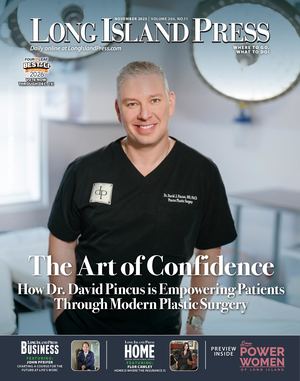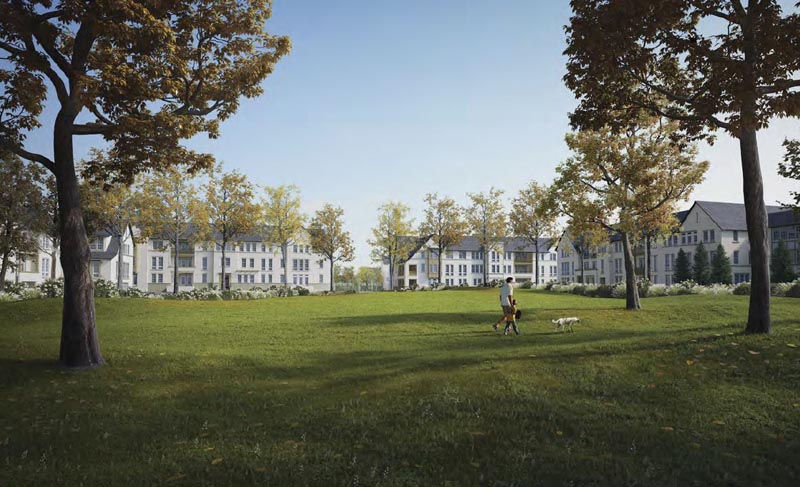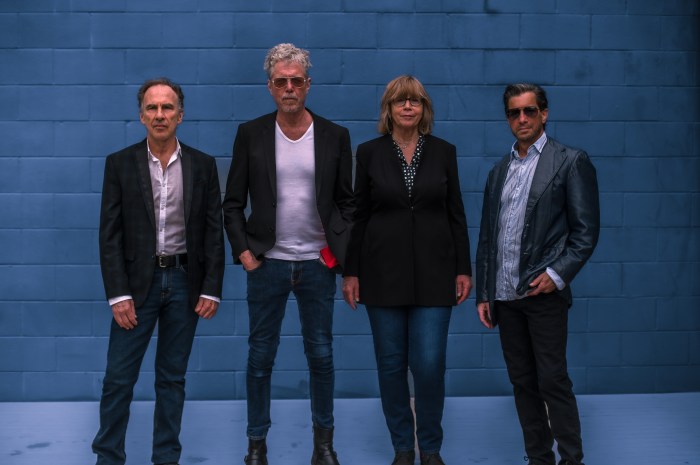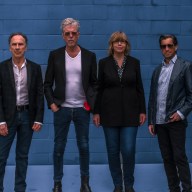Claims less impact, more property taxes
Part 3 of 3
Click here to view Part 1 and Part 2

To learn more about the project, including the environmental impact statement and its appendices, visit oysterbaytown.com/information-syosset-park-draft-eis.
When, in June 2001, the Town of Oyster Bay denied approval to the Taubman Company to turn the 39 empty acres of the former Cerro Wire site into a giant regional mall, it represented a triumph for the Cerro Wire Coalition. A mix of civic and business organizations and school districts, it had come together to successfully oppose Taubman’s plans.
The victory also left a problem: What to do with the 39 barren acres that had been a state Superfund site and environmentally remediated?
So the coalition formed an Alternative Development Committee to study possible other uses and contact potential developers. It was also, according to people familiar with the history, an attempt to move away from the feeling that the coalition was merely driven by “NIMBY” concerns.
In 2013, new players entered the picture. Simon Property Group and Castagna Realty Company reached an agreement with Oyster Bay to buy the town-owned 53.8 acres adjacent to the Cerro property. Due to a financial squeeze, the town was looking to sell the land, which it declared surplus. The property included the old Syosset landfill, a federal Superfund site, and about 15 acres that held its Department of Public Works (DPW) and animal shelter and other operations.
It took a court-ordered public referendum to approve the $32.5 million sale in 2013, of which the town immediately received $30 million. By terms of the sale, the town could keep its operations there an additional five years, with a three-year extension, which it recently exercised. The town still owes title, and will transfer the property and earn the final $2.5 million at closing.
The following year, the new group purchased from Taubman the Cerro Wire property to take control of the full 92.8 acres. It will be seeking town approval and a change in zoning to turn its project, Syosset Park, into a reality. As of now the area is zoned light industrial.
The ideas of the Alternate Development Committee percolated into Syosset Park’s design. And what the developers presented to the public earlier this year in its Draft Environmental Impact Statement (DEIS) was a mixed-use plan incorporating 625 housing units, two hotels, retail, office space and even a movie theatre.

Guiding The Project
Anton Media Group interviewed Charles Davis, senior vice president of development for Simon Property Group, and the late John J. Gutleber, president and CEO of Castagna Realty Co., to talk about the proposed Syosset Park project being developed by Syosset Park Development, LLC.
Davis observed, “[Residents] spent 20 years fighting the mall. And I think they came to the conclusion that if you say ‘no’ you may end up with something that you don’t want. And I think they came up with mixed-use because they didn’t want what the alternative was.”
He added, “And we’re going through the generation of people who just moved here and don’t realize it’s not public land that we’re looking to do something on. We own the property and we have certain rights to it. We’ll own the town [DPW] property once they move out. We’re trying to create something here that will be here for the longest time. At some point, it’s going to be something. We were directed by the community that they wanted mixed use.”
According to the DEIS, the project is expected to bring in about 1,600 residents and 243 school-age children (the Syosset School District has come up with an estimate of 381). Property taxes currently generate about $1 million. That figure, once the project reaches its full economic potential, could rise to about $20 million, including $12 million to the school district.
Commented Davis, “We didn’t have to do the level of alternative analysis in the DEIS that we did, but we did it so we can demonstrate that, from an impact perspective, Syosset Park was far less impactive than what you could do by right: office park, industrial business park, an Amazon distribution center, or the mall. All those were viable options, some that you could do by right. Or you can do this mixed-use solution, [which results in] less traffic, which means better air quality and less noise. [The DEIS] shows that there would be just as much, if not more, taxes generated [by Syosset Park].”
 What Happens Next?
What Happens Next?
The comment period for the DEIS ended on Aug. 31, and Syosset Park Development will now have to respond to many concerns and questions raised by residents, public officials and the Syosset School District.
CD: “We have to get all the comments compiled, then responded to, by professional experts and specialists. The town then will have to review [the responses] to determine that they have been adequately responded to, and to determine that the remediation measures proposed in the DEIS are adequate for the issues there. Only then would they consider a final DEIS for certification as a basis to take up the land use decision [as to] if this is the right project, or this is what we like to see changed to get to the right project.”
Davis believes that by next summer, at best, the town will be having these discussions and in parallel, the developer will have to finish its own environmental investigation.
“There’ll be a full year of design and permitting before you can begin putting in the utility infrastructure,” said Davis.
Environmental Testing
At a May 1 public scoping session to comment on the DEIS, and subsequently on social media and town board meetings, many people called for independent environmental testing of the site, given its history. The town listened, and Syosset Park Development agreed to fund this testing. It will add to the project’s timetable, as the town decided to leave the comment period on this testing open until the end of next January.
CD: “We’re very sober about what was here. We’re very sobered by decades of a process to get here. And the fact that the landfill sat empty from the ‘70s to the ‘90s, when it was capped, certainly warrants making sure. We’re going to be here for decades. We’re not going anywhere.”
JG: “People may have kept the prejudice against the site, even if this project wasn’t done.”
Part of this prejudice may have to do with the toxic legacy of the site; numerous speakers at the meeting talked of family and friends in the neighborhoods surrounding the property who had succumbed to cancer.
 From a Frequently Asked Questions (FAQ) release by the developer: “We’re in agreement an independent follow-up of the data and reports to date should be performed, and as warranted, additional confirmatory testing should occur so that our concerned neighbors have that independent confirmation of what is there today….Absent Syosset Park, the issues raised by some members of the community will not go away. We didn’t create the existing conditions, but we’re committed to making things less impactive to the neighbors and South Grove School through Syosset Park.”
From a Frequently Asked Questions (FAQ) release by the developer: “We’re in agreement an independent follow-up of the data and reports to date should be performed, and as warranted, additional confirmatory testing should occur so that our concerned neighbors have that independent confirmation of what is there today….Absent Syosset Park, the issues raised by some members of the community will not go away. We didn’t create the existing conditions, but we’re committed to making things less impactive to the neighbors and South Grove School through Syosset Park.”
From the FAQ: “An application has been made to have the Cerro Wire site reevaluated under the more stringent current New York State Brownfield Cleanup Program, versus standards in place nearly 20 years ago when the factory buildings finally came down, and the site was then deemed safe to develop. All development on the DPW site will require the oversight of the EPA as well as the state departments of Health and Environmental Conservation.”
“It represents a higher level of cleanup with this project in deference to the community’s concerns about the site’s history,” Davis said of the Brownfield program.
Anton Media Group: “The town will continue to monitor the landfill?”
CD: “At the end of the day, it’s the town’s. That’s never going to change. We’re not going to assume responsibility or liability for the actual landfill. That’s an in-place condition [ordered by the EPA} that will never change. Nobody is lifting the landfill [cap]. We’re putting something on top of the [cap] that’s not salt trucks or snow trucks and piles of debris from Superstorm Sandy. We’ll never break into the cap again.”
On Hotels
Davis said that a hotel was mentioned by the Alternative Development Committee as a possible part of the site.
Gutleber said there are few hotels on the north shore, and there was a need for places for business travelers to stay and conferences to be hosted.
“We did market studies and there’s absolutely a market [for a hotel],” Davis said, adding that a quality, boutique hotel firm has committed to placing one at the site. He added that hotels don’t generate as much traffic as the alternate uses.
A second hotel on the site would be an extended stay model.
Office/Retail Space
As far as retail, the town wanted less than what the Taubman mall plan called for, according to Davis, who noted that Syosset Park was a perfect fit and “sweet spot” for “certain high-quality lifestyle retailers…they don’t want to be in the malls and they can’t go in the Americana in Manhasset.”
He added, “There’ll be local retail. We already have retailers that would sign up today.”
 Anton Media Group: “Is there an office space glut, with too many empty offices?”
Anton Media Group: “Is there an office space glut, with too many empty offices?”
JG: “We just built the newest office building on Long Island. It’s the headquarters of Dealer Track. It’s a stunning building, 180,000 square feet on New Hyde Park Road, right [next to] the Ritz-Carlton. A smaller version of that, say 120,000 square feet, would make sense [at Syosset Park]. A [corporation] would love to have its headquarters in a village setting, with apartments nearby and a hotel there for conferences. It would be a self-contained village complete with small market.”
He added, “We own 10 office buildings on Long Island. Our vacancy rate is 4 percent”.
CD: “We have properties across the country, malls like Roosevelt Field and Walt Whitman, and also have mixed-use properties with offices. And just to echo what John said, we’re finding this next generation of business clients—technology, back office and the like—they’re actually searching for these type of projects, instead of the 1980s version of the office campus.”
JG: “Dealer Track wanted to have a headquarters that was cool and up-to-date…because they want to attract smart young kids and not have them go into the city. Basically [an office in Syosset Park], is a human resource thing—’Here’s our headquarters. There’s a basketball court. You could eat here and there’s a hotel here.’ And we’ll have a shuttle to take them to Hicksville train station. Even though it’s not transit-oriented, it really is because we’re so close and we have the shuttles. [The point is] to attract young talent.
Traffic Studies
Anton Media Group: “There was pushback on traffic. Most people believe you underestimated the amount of traffic generated by the project.”
CD: “That’s pretty standard [response]. In all my years of dealing with the DEIS, nobody ever says you got the traffic right.
JG: “Sometimes, people don’t realize that we’re making things better. That’s the point.”
CD: “What we are focused on [is], what can we have here that will have the least amount of rush hour traffic, but still make economic sense? We’re actually spending money to fix roads.”
The DEIS, in conclusions based on traffic and parking studies, states that the mixed-use development will have the least impact of the possible uses—mall, industrial park or office park.
Among its points:
- “The construction of Syosset Park would result in an increase in the number of trips occurring within the study area. These trips can be accommodated with the proposed site access plan and recommended off-site mitigation.”
- “… discontinuing the use of the 54-acre easterly portion of the site currently occupied by operating Town of Oyster Bay facilities. This results in the elimination of traffic associated with that operation, including a significant number of trucks used in town maintenance operations.”
- “A range of roadway improvements has been identified to facilitate access to and from Syosset Park and mitigate identified impacts on the adjacent roadways and intersections evaluated.”
- “With the implementation of these improvements, the cost of which will be borne by the developer with no cost to the public, the roadways, intersections and ramp areas studied can accommodate the additional traffic anticipated with the development of Syosset Park while minimizing any impacts.”
Final Words
JG: “A mixed-use [development] make sense. It generates taxes for the community. It gives you the ability to be flexible within your approved framework.”
CD: “For those who want to participate with us, and tell us what they want to see here, we think we’ve come up with a plan that really provides everybody with [what they] want. For people who are just showing up and never came to the community meetings, we’ll meet with them anyplace, anytime, anywhere. If you don’t like it, tell us pieces that you don’t like and why. I will go back and figure out how to respond.”
Davis concluded, “I’ve been on all sides of the equation. I used to run a homeowners association in my community. I used to work on the public side. I’ve been in development for over 20 years. I worked in California. I live in California. There isn’t a project that doesn’t have controversy. The issue is, what’s the right solution here?”



































